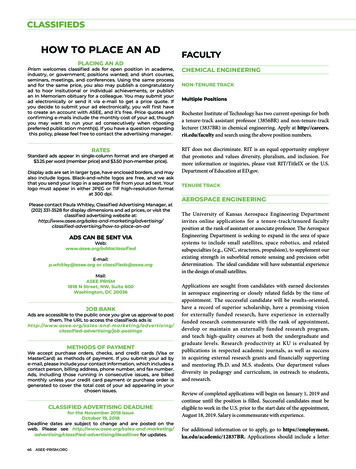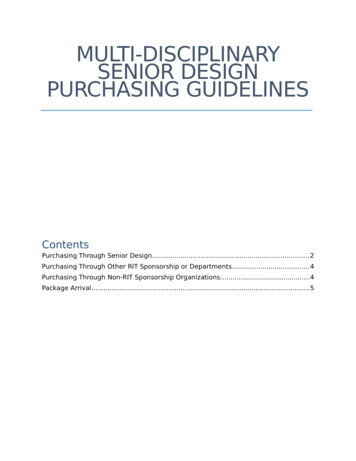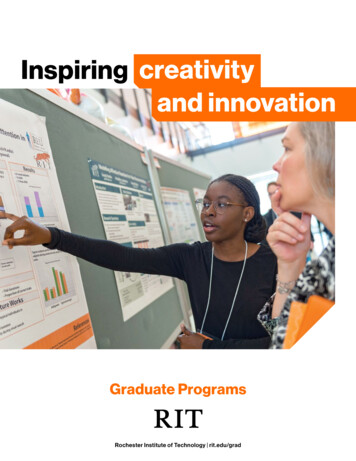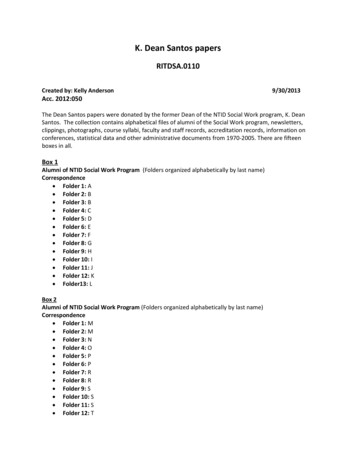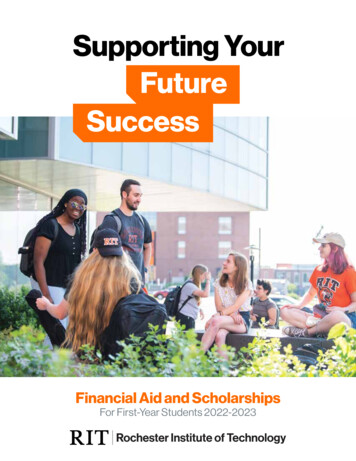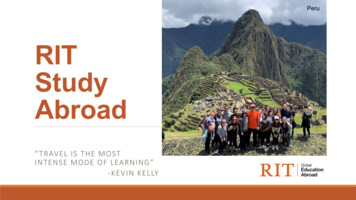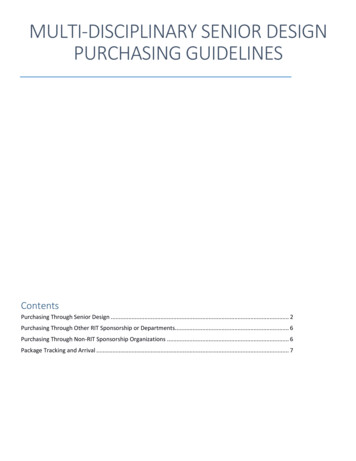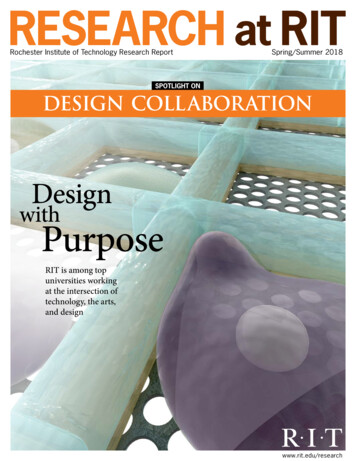
Transcription
Supporting YourSuccessRIT/NTID Financial Aid and Scholarships
An Exceptional ValueAn Outstanding InvestmentAn Affordable ChoiceRIT has been recognized by leading college rankings and guides for its value andaffordability, including The Fiske Guide to Colleges, Kiplinger Magazine, and PrincetonReview. In the 2020 U.S. News & World Report “Best Value Schools” list, RIT ranked#50 among national universities.A Commitment to AffordabilityRIT offers a comprehensive financialaid program consisting of merit-basedscholarships and a full range of need-basedgrants, loans, and campus employmentprograms that provide assistance to RITstudents and families. Last year, RITundergraduates received more than 342million from all sources, including morethan 190 million in scholarships and grants.In addition, many students take advantageof our payment plans, tuition pre-paymentplan, and opportunities for students toearn substantial salaries through RIT’sinternationally recognized cooperativeeducation (co-op) program. We believe thatwe can help you and your family afford thequality education you are looking for. Theinvestment you make in an RIT educationwill last your lifetime.Merit-Based ScholarshipsMerit-based scholarships at RIT areawarded in recognition of outstandingacademic and extracurricular achievements,regardless of a student’s financial need.These scholarships are most often awardedbased on a review of information alreadyprovided to RIT’s Office of UndergraduateAdmissions as part of the admissionprocess. A separate application is notrequired for most of these scholarships.2Some students who are awarded meritbased scholarships choose not to applyfor need-based financial aid. Many othersreceive merit-based scholarships as part ofa comprehensive financial aid award thatmay also include RIT need-based grants,federal- or state-sponsored grants, loans,or employment opportunities.94%of incoming first-yearstudents receivedmore than 57min RIT grant andscholarship aidNeed-Based Financial AidNeed-based financial aid is awarded tostudents who demonstrate financial need.The information your family provideson the Free Application for FederalStudent Aid (FAFSA) is used to calculatean expected family contribution towardeducational expenses, based on agovernment-approved formula. If yourexpected family contribution is less thanthe total cost of an RIT education (tuition,fees, room and board, and allowancesfor books, supplies, transportation,and personal expenses), you havedemonstrated financial need. The Officeof Financial Aid and Scholarships willdetermine your eligibility for RIT, federal,and other financial aid programs based onfinancial need.Applying for Need-BasedFinancial AidAt RIT, new students complete only theFAFSA to apply for need-based financialaid. You automatically will be consideredfor all need-based financial aid programsprovided by RIT, as well as federal and statefinancial aid programs. You can completethe FAFSA online.Here is how to apply: You may completethe FAFSA online at www.fafsa.ed.gov.Have results sent to RIT by including ourfederal school code, which is 002806.rit.edu/financialaid
Admissionapplicationand FAFSAprioritydeadlinesEARLYDECISION 1EARLYDECISION 2REGULARDECISION11/11/11/15The application is available beginning October 1, but ourpriority filing deadlines, which are listed above, ensurethat you will receive your award information prior to youradmission deposit deadline.Your Financial Aid AwardIf you are a resident of New York state, you also can applyfor the New York State Tuition Assistance Program(TAP) by completing the TAP on the Web application athesc.ny.gov/tap. If you are not a resident of New York state,check with your state scholarship agency to see if you canuse your state scholarship or grant at RIT.Your award may include grants, scholarships, studentloans, or part-time employment. The scholarship andfinancial aid programs used most often at RIT are outlinedin charts on pages 6 and 7 of this publication.Your financial aid award may contain a combination ofseveral types of aid from a variety of sources, includingthe federal government, state government, and RIT.Basic Steps for First-Time Applicants12Apply for admissionComplete the FAFSAYou should startyour application foradmission early in yoursenior year. RIT will notoffer you a financial aidaward until you havebeen admitted.This should be done assoon after October 1 aspossible. Have resultssent to RIT by includingour federal school code,which is h for yourStudent Aid Report(SAR)You will receive a SARwhen you file yourFAFSA. Your SAR willbe sent to the emailaddress you list on theFAFSA. Review the SARand make any neededcorrections.4Apply for statescholarships, grants,and vocationalrehabilitationCheck with your statescholarship agency forapplication informationand forms. Deaf orhard-of-hearingstudents shouldapply for vocationalrehabilitation bycontacting the officenearest your home.5Research othersources of aidUse free, reputablesources of informationon private scholarships.We provide links to themajor sources directlyfrom our website.rit.edu/financialaid3
RIT OffersQualityand ValueRIT is perennially recognized as one of the world’s leading universities. U.S. News & World Report ranks RIT104th in the “National Universities” category. That samepublication has listed RIT’s College of Art and Design,Saunders College of Business, and Kate Gleason Collegeof Engineering among the country’s best. PrincetonReview includes RIT in its 2020 “Best 385 Colleges” andthe 2017 edition of Colleges That Create Futures.Merit-Based Scholarshipsfor Upperclass StudentsThe RIT Nathaniel Rochester Society (NRS) Scholarshipis a merit-based scholarship created in 1991 to recognizeRIT undergraduate students for their outstandingacademic and leadership achievements here at RIT. Morethan 100 scholarships are awarded each year by the NRSScholarship Committee. The maximum award is 2,000for four semesters of academic study, and the scholarshipis available to students who have achieved second-yearstanding at RIT with a GPA of 3.4 or higher.
2020–2021UndergraduateFreshmanScholarships andFinancial AidMerit-Based Scholarship General GuidelinesAll admitted freshmen are reviewed by the Scholarship Selection Committeeto determine each student’s eligibility for RIT merit-based scholarships.Unless otherwise noted, no separate application is required.Merit-based scholarships are competitive and are awarded in recognition ofexceptional or outstanding academic achievement. Consideration may alsobe given to outstanding leadership, service, entrepreneurship, citizenship, orcreativity. Portfolio evaluations or other evidence of creative excellence will also beconsidered for applicants to art, crafts, design, film, and photography programs.To receive full consideration, applicants for fall entry must apply byNovember 1 (Early Decision 1), January 1 (Early Decision 2), or January 15(Regular Decision). Unless otherwise noted, merit-based scholarships requirea 2.8 cumulative grade-point average for renewal and may have additionalhousing requirements.Notes This chart covers the most commonly awarded financial aid programs available to full-timeundergraduate students at RIT. Information is correct as of August 2019. Most programs require satisfactory progress toward degree completion to maintaineligibility (see RIT Undergraduate Bulletin). Federal student aid programs are subject to government appropriations. Filing the FAFSA by the priority filing date will ensure priority consideration for all programs.Applications filed after this date will receive consideration as long as funds remain available.
Additional Merit-BasedScholarshipsRIT National Merit ScholarshipsRIT National Hispanic Scholar AwardRIT National Co-op ScholarshipsRIT/FIRST Robotics ScholarshipsRIT Project Lead The Way ScholarshipsRIT Computing Medal ScholarshipsRIT Innovation & Creativity Award ScholarshipsRIT/NTID Technology Scholar AwardMerit-Based ScholarshipsRIT/NTID Creative Scholar AwardNTID President’s Scholarship for Academic ExcellenceRecipients are selected based on their academic records, recommendations, activities,and the requirements for their academic program.NYS STEM Incentive ProgramNTID Academic Excellence ScholarshipsVeterans Benefits(GI Bill, Vocational Rehab., Yellow Ribbon)Recipients are chosen on the strength of their overall application materials: grade-pointaverage, SAT/ACT scores, activities, and recommendations.NTID Associate Bachelor’s Degree ScholarshipsRecipients are those who are admitted into an associate bachelor’s degree programand are chosen on the basis of their grade-point average, SAT/ACT scores, activities, andrecommendations.RIT Performing Arts ScholarshipsRecognizes individual achievement and talent in the performing arts. Regardless ofmajor, all full-time admitted freshman undergraduates are eligible for consideration. Aseparate application and a digital audition are required. Amounts vary. Renewable basedon continued participation in the performing arts at RIT. For more information, see rit.edu/financialaid.Need-Based GrantsNTID Grant-in-AidRIT/NTID GrantRIT RCSD ScholarshipsSay Yes to Education ScholarshipsTuition Assistance Program(New York State)Federal Pell GrantFederal Supplemental Educational Opportunity GrantMerit-Based Scholarships for students accepted directly to RIT bachelor’s degree programs.Other State GrantsRIT Presidential ScholarshipsAwarded to a select number of entering freshmen. Recipients demonstrate exceptionalacademic performance, and receive exemplary letters of recommendation as well asstrong entrance exam scores. Amounts vary. Renewable.RIT Founders ScholarshipsNamed to recognize the founders of RIT and its forerunners, Founders Scholarships areawarded to admitted freshmen who are outstanding academically, are active and involvedin their schools or community, or demonstrate special talents or abilities. Considerationmay also be given to outstanding leadership, service, entrepreneurship, citizenship,or creativity. Portfolio evaluations or other evidence of creative excellence will also beconsidered for applicants to art, crafts, design, film, and photography programs. Amountsvary. Renewable.In addition to the award criteria listed above, the merit-basedscholarships shown at right have specific selection criteriaand/or application procedures.LoansFederal Direct LoansFederal Direct Loans—Independent StudentsFederal Direct PLUS LoansEmploymentFederal Work-Study ProgramRIT Employment Program
EligibilityAmountAdditional Information/Where to ApplyAwarded to admitted freshmen who are National Merit Scholar finalistsand name RIT as their first-choice choice school for NMSC. 2,000 per year. Renewable as long as student meetsNMSC guidelines.RIT will receive finalist rosters from NMSC. Recipients of these awardsautomatically qualify for our highest Presidential ScholarshipsAwarded to admitted freshmen who are recognized by the College Boardas National Hispanic Recognition Scholars. 2,000 per year. Renewable.RIT will receive an official roster from the College Board NHRS program.Awarded to outstanding admitted freshman students who, through theiressay, reflect a clear enthusiasm for experiential learning. 2,500 per year. Renewable. Up to 10 awarded each year. Submit scholarship application online at: waceinc.org.Awarded to outstanding admitted freshman applicants who haveparticipated on a high school FIRST team. 2,500 per year. Renewable. Up to 20 awarded each year. Download scholarship application at: firstinspires.org.Awarded to outstanding admitted freshmen who have completed two ormore PLTW courses. 2,500 per year. Renewable. Up to 20 awarded each year. Submit a letter of recommendation from a PLTW teacher along with RITadmission application and school transcripts by January 15.Award recipients nominated by their high schools who are admitted andenroll at RIT in the fall immediately following graduation from high school. 8,000 per year. Renewable.Eligible students must be nominated by their high schools in the junioryear for consideration.Deaf and hard-of-hearing award recipients nominated by their high schoolwho are admitted and enroll at RIT in the fall immediately followinggraduation from high school. 1,000 award. Renewable.Eligible students must be nominated by their high schools in their junioryear for consideration.Deaf and hard-of-hearing award recipients nominated by their high schoolwho are admitted and enroll at RIT in the fall immediately followinggraduation from high school. 1,000 award. Renewable.Eligible students must be nominated by their high schools in their junioryear for consideration.For qualified NYS residents matriculated in an approved undergraduateprogram in Science, Technology, Engineering, or Mathematics in New Yorkstate. 6,800Full eligibility requirements and applicant guidelines can be found at:hesc.ny.gov/stem.Eligibility depends on veteran benefit being sought.Can cover up to full cost of attendance depending onprogram and other aid sources.Contact the Veterans and Military Services Office at 585-475-6641 or visitour Military & Veterans website: rit.edu/admissions/veterans.Students demonstrating financial need.Amounts vary depending on need.File the Free Application for Federal Student Aid (FAFSA) after October 1.Students demonstrating financial need.Amounts vary depending on need.File the Free Application for Federal Student Aid (FAFSA) after October 1.Awarded to qualified freshmen who are graduates of the Rochester CitySchool District who have both lived in the city and attended an approvedhigh school within the RCSD for the last three years of high school.Full tuition through a combination of RIT scholarships andstate and federal need-based grants.Must apply for admission to RIT by January 15 and be certified by thehigh school guidance office to be considered.In partnership with Say Yes to Education, awarded to participants in theSay Yes to Education program.Full tuition through a combination of the RIT scholarshipsand state and federal need-based grants.Must apply for admission to RIT by January 15 and be certified by Say Yesto be considered.Full-time students who are New York state residents and meet stateincome guidelines. 500 to 5,165 per year for entering freshmen.File New York State TAP Application and the Free Application for FederalStudent Aid (FAFSA).Students who are pursuing their first bachelor’s degree and meet need criteria. 657 to 6,195 per year. Prorated for part-time study.File the Free Application for Federal Student Aid (FAFSA).Students with high financial need (normally those who qualify for FederalPell Grant). 100 to 4,000 per year. Average award is 500.File the Free Application for Federal Student Aid (FAFSA).Varies.Amounts vary.State education department in state of residency.All students enrolled at least half time in a degree program.Maximum amount: 1st year: 3,500; 2nd year: 4,500;3rd, 4th, 5th: 5,500. Additional maximum 2,000Unsubsidized Federal Direct Loan—all years.File the Free Application for Federal Student Aid (FAFSA).All independent undergraduates enrolled at least half time in a degreeprogram.Maximum amount (including unsubsidized): 1st year: 9,500; 2nd year: 10,500; 3rd, 4th, 5th: 12,500.File the Free Application for Federal Student Aid (FAFSA).Parent of a dependent student who is enrolled at least half time in adegree program.Total cost of education minus all other financial aidawarded.File the FAFSA and apply online at studentloans.gov.Students with financial need. Most jobs provided on campus. Somecommunity service positions are available.Varies, depending on hours and wage rate.RIT wage rates start at 11.10 per hour.File the Free Application for Federal Student Aid (FAFSA).No financial need requirement. May be on campus or off.Varies, depending on hours and wage rate.RIT wage rates start at 11.10 per hour.RIT Student Employment Office.7
What does it cost forNTID-sponsoredstudents to attend RIT?RIT receives special federal support for deaf and hardof-hearing students. As a result, we are able to offeryou a top-quality education at a substantially reducedtuition rate. Student expense budgets include a 2,088yearly allowance for estimated books, transportation,and personal expenses. Financial aid awards takethese estimated costs into con sideration in additionto tuition and fees and room and board, so that youraid award more accurately reflects all costs associatedwith your attendance.2019-2020 Charges for Full-Time Resident StudentsEnrolling for the First Time Fall Semester 2019Academic Year (Based on 2 Semesters) 31,348 17,162Tuition 7,902Residence Hall Room (Double) 5,638Board Plan (Standard) 646Student activity/health services feesStudents from all income ranges are offered aid, andas a result, find an RIT education to be affordable.Office of Financial Aidand ScholarshipsBausch & Lomb Center56 Lomb Memorial DriveRochester, NY 14623-5604585-475-2186ritaid@rit.edu8For deaf and hard-of-hearingstudentsNTID Office of Admissions52 Lomb Memorial DriveRochester, NY 14623-5604585-475-6700585-743-1366 (videophone)ntidaid@rit.edu
Financing Options at RITThere are several loan programs, employment programs, and payment plans available to assist families in meetingeducational costs. The programs listed below are available to students or parents without regard to financial need.Any family may participate in one or more of these programs:1Payment OptionsStudent FinancialServices offers a numberof payment options that willallow you to schedule yourpayments each semester.Information is included inOrientation materials, orcontact Student FinancialServices at 585-475-6186.2RIT TuitionPrepayment PlanThis plan allowsyou to prepay two or moreyears’ tuition costs at thecurrent tuition rate. Studentsreceiving need-based financialaid are not eligible for thisplan, but students who receiveonly merit-based scholarshipsmay participate. ContactStudent Financial Services at585-475-6186.3Federal Direct LoanThe Federal DirectLoan program is themost widely used student loanprogram, and it includes an“unsubsidized” Direct Loanprogram. The subsidizedprogram allows interest to bepaid by the government whilethe student is enrolled; theunsubsidized program requiresinterest to be paid by thestudent while attending schoolunless the student opts to haveinterest capitalized (interest isadded to the principal amountborrowed) so no payment isrequired while in school.This means that any RITstudent enrolled at leasthalf time may borrow themaximum loan amount forthe current academic year. Seepage 7 for more information.studentloans.gov4Federal DirectPLUS LoanPerhaps the mostpopular aid program used tofinance the family contributionis the Federal Direct ParentLoan for Under graduateStudents (PLUS). This is afederally guaranteed loan thathelps parents of dependentundergraduate students financeeducation costs. A parentmay borrow up to the full costof education minus otherfinancial aid awarded. PLUSloans have a fixed interest rateset by the federal government.Parents who are denied for thePLUS loan based on a reviewof their credit may requestthat an additional FederalDirect Unsubsidized Loan beprocessed in the student’s name.Dependent students may beeligible for up to 4,000 as afreshman or sophomore, and 5,000 as a junior or senior.studentloans.gov5RIT StudentEmploymentThis program issimilar to the Federal WorkStudy Program, but doesnot take financial need intoconsideration. Students areemployed on or off campusand earn wages that maybe used to meet educationexpenses. Employment iscoordinated through RIT’sStudent Employment Office.6CooperativeEducationPaid cooperativeeducation (co-op) employmentis a required or optionalcomponent of most degreeprograms at RIT. While studentsdo not typically enter co-oppositions until after their secondyear of study, co-op earningsfrom that point can representa substantial contributiontoward college expenses. Lastyear, co-op students generatedmore than 105 million throughemployment (see page 10).7AlternativeEducation LoansAlternative EducationLoans are private (non-federal)loans offered through banksto supplement financial aidawards. We encourage studentsand families to use alternativeloans as a last option after firstpursuing all federal loan options(Direct and PLUS). Visit ourwebsite for more information.rit.edu/financialaid9
FAQWe want to help you understand the insand outs of financing your collegeeducation at RIT. Here are some questionswe frequently receive from prospectivestudents and parents:10
If I am a deaf or hard-of-hearing student enrolling in a BSdegree program, do I pay the same rate as a hearingstudent?No, once you are accepted into a bachelor’s degree program asa deaf or hard-of-hearing student, you will pay reduced tuitionrates (see page 8).We’ve been told we probably will not qualify for aid. Shouldwe bother to apply?Yes, you should! Many factors are taken into considerationin determining a family’s financial need, and each family’scircumstances are unique, so you can’t know what you’llqualify for without completing the aid application process.There is no arbitrary cutoff for determining a family’s eligibilityfor financial aid. The income range of those eligible for someamount of assistance is wide.When should I apply for aid?You should file your FAFSA after October 1 or soon after youhave applied for admission. Our priority filing deadline dates areestablished so we can notify you of your aid eligibility as soon aspossible after you have been admitted. Don’t wait until you havereceived your admission notification to complete the FAFSA!Will I be eligible for the same amount of financial aideach year?In most cases, the answer is yes, but not in every case. Everyeffort will be made to continue a similar level of institutionalgift aid each year. Students receiving merit-based scholarshipsdo not need to reapply to renew those scholarships. Meritbased scholarships automatically will be renewed at the samelevel, as long as the renewal requirements are met.Students must reapply for need-based financial aid eachyear. Assuming you remain in good academic standing,file the application forms by the recommended deadline,and demonstrate a similar level of need, you can expectapproximately the same level of institutional gift aid each year.Examples of circumstances that might cause a change in aneed-based financial aid award could include, but are notlimited to: a significant rise or drop in family income; more or fewer siblings in college at the same time you areattending RIT; and more or fewer family members living at home.Are all families expected to contribute toward educationexpenses?If the student is dependent upon his or her parents forsupport, then the expected family contribution will includeamounts from both the student and parents based on theirrespective incomes and assets. The contribution for studentswho are financially independent of their parents is based onthe student’s income and assets, as well as on those of thestudent’s spouse if married. The amount you potentially needto contribute toward education expenses is the differencebetween your cost of attendance (see page 8) and the financialaid you are offered.If my parents are divorced or separated, which parentshould provide the information required to apply for aid?You should answer the questions using information aboutthe parent you lived with in the past 12 months. If you didnot live with one parent more than with the other, provideinformation for the parent who provided you the mostfinancial support. (Support would include money, gifts,loans, housing, food, clothes, medical care, etc.). Childsupport payments from your other parent will be taken intoconsideration, and information about the income and assetsof any stepparent must also be provided. We realize thesesituations can be sensitive and complicated. Please feel freeto discuss your individual circumstances with one of ourcounselors. All information will remain confidential.What is an EFC?EFC stands for Expected Family Contribution. This is used byall colleges and universities to determine a student’s eligibilityfor federal financial aid programs. The EFC is calculated bythe federal government’s processor, based on the informationyou provide on the Free Application for Federal Student Aid(FAFSA), using a formula known as the federal methodology.Your EFC will be the same at all colleges that receive resultsfrom your FAFSA. After you file your FAFSA, you will receiveinformation from the federal processor that will inform you ofyour calculated EFC.What happens if our financial need changes after I entercollege?While many families’ financial needs remain constant whilea student is attending college, some families will experiencesignificant changes in their ability to contribute to theirchildren’s education. Sometimes these changes can even occurduring the middle of an academic year. We are always willingto review financial aid appeals from families experiencingdifficulties due to significant changes in their circumstances.Contact our office for additional information.I was notified that I will receive a scholarship from my highschool. Will this scholarship affect my financial aid?We encourage students to apply for scholarships awarded byprivate organizations. In many cases, no alteration to a student’sfinancial aid award is necessary. If we are required to amendthe financial aid award as a result of receiving an “outsidescholarship,” we will make every effort to reduce the student’sloan and/or Federal Work-Study award before reducing anyRIT grants. Merit-based scholarships usually are not impacted.You can find links to many sources of free and reputableinformation concerning outside scholarships on our website.rit.edu/financialaid11
VocationalRehabilitationVocational rehabilitation is a federally funded state program that helps people withdisabilities find a suitable occupation. Because education and training can be anintegral step in getting a good job, Vocational Rehabilitation often provides collegefunding to residents who meet specific requirements.All deaf and hard-of-hearing students are expected to apply for VR. To apply forVocational Rehabilitation funding, contact the Vocational Rehabilitation office nearestyour home. Vocational Rehabilitation agencies in each state have their own methods ofdetermining if you will be eligible for funding and the level of support you may receive.There is no national standard.The RIT Office of Financial Aid and Scholarshops will include an estimate of your VRsupport in your award notification if we believe you might be eligible. However, onlyyour state VR agency can determine your eligibility and the dollar amount. Should thisdiffer from our estimate, RIT will adjust your financial aid award(s) if necessary.Four Important Things to Ask Your VR Counselor:Q1Q2How does my state decide howmuch funding I will receive?If I receive Supplemental SecurityIncome, does that affect the VRsupport I am eligible for?Q3Q4Does it matter if my parents claimedme on their taxes?NTID has a summer orientationprogram for new studentsenrolling in an associate degreeprogram. Will VR pay for thisorientation program?Additional information about Vocational Rehabilitation and a state-by-state directory ofVR agencies can be found on our website.rit.edu/ntid/vrFINANCIAL BENEFITS OFCooperativeEducationAll academic programs at RIT offer an experiential component. Some programs require apracticum or internship, and many feature an optional or required cooperative educationcomponent. RIT’s cooperative education (or co-op) program offers more than 4,500students practical employment experience in conjunction with classroom learning eachyear. Co-op typically begins after completion of the sophomore year and requires thatthe student spend two or more co-op work periods employed in a full-time, paid positionrelated to the student’s academic interests. Nearly 3,400 co-op employers across theUnited States and overseas participate in RIT’s cooperative education program.In addition to work experience, there are significant financial advantages to participatingin co-op. Last year, co-op students generated more than 105 million through employment.Average co-op salaries for specific academic programs may be obtained from the Officeof Career Services and Cooperative Education website at rit.edu/oce. A portion of thesecooperative education earnings can be used to offset tuition expenses charged when thestudent returns to the classroom.Since tuition and fees are not charged while students are employed in co-op and not attend ing classes, the tuition costs associated with four years of education can also be spread overa more extended period of time. This often makes an RIT edu cation even more affordable.12
Additional InformationFinancial aid awards for admitted candidates will outline scholarships, grants,work-study opportunities, and low-interest student loans.What about the CSS Profile Form?Please note that RIT has chosen not to use the College Scholarship Service FinancialAid Profile form used by some universities to process financial aid awards. Usingthe Federal FAFSA will allow you to apply for financial aid with no processing feeand will allow us to process your financial aid information more quickly.Financial Aid and Scholarships Office /AppointmentMonday–Friday8:30 a.m.–4:30 p.m.585-475-2186ritaid@rit.eduTax Benefits and Other Help with College ExpensesThere are some significant tax benefits for families of college students.The American Opportunity Tax Credit can be claimed for tuition and certainfees you pay for higher education. It is a tax credit of up to 2,500 of the cost ofqualified tuition and related expen
essay, reflect a clear enthusiasm for experiential learning. 2,500 per year. Renewable. Up to 10 awarded each year.Submit scholarship application online at: waceinc.org. RIT/FIRST Robotics Scholarships Awarded to outstanding admitted freshman applicants who have participated on a high school FIRST team. 2,500 per year. Renewable.
